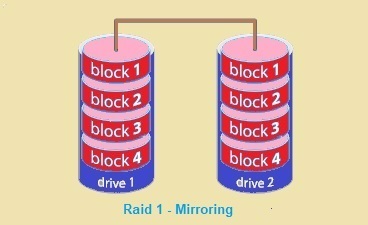RAID 1 Data Recovery
RAID Data Recovery Services
RAID 1 data recovery is basic disk mirroring where you have copies of all your data in one big bucket. This has a recovery but slows down your applications.
Data are stored twice by writing them to both the data drive (or set of data drives) and a mirror drive (or set of drives). If a drive fails, the controller uses either the data drive or the mirror drive for data recovery and continuous operation. You need at least 2 drives for a RAID 1 array.

Advantages of RAID 1
Disadvantages of RAID 1
RAID Failures
 RAID controller failure
RAID controller failure Rebuild failure
Rebuild failure Damaged striping
Damaged striping Multiple drive failure
Multiple drive failure Drive not detecting in BIOS
Drive not detecting in BIOS  Configuration damage or corruption
Configuration damage or corruption
